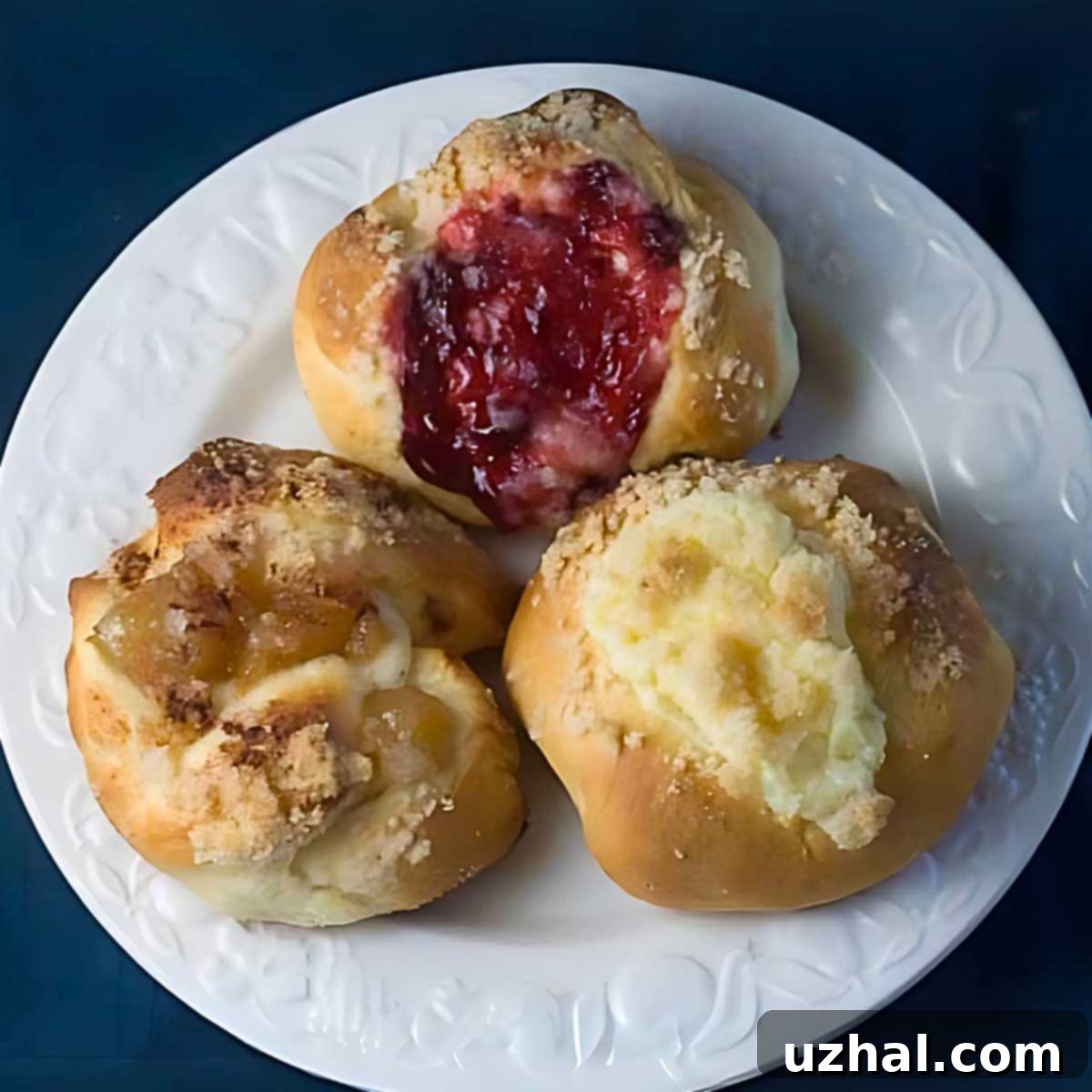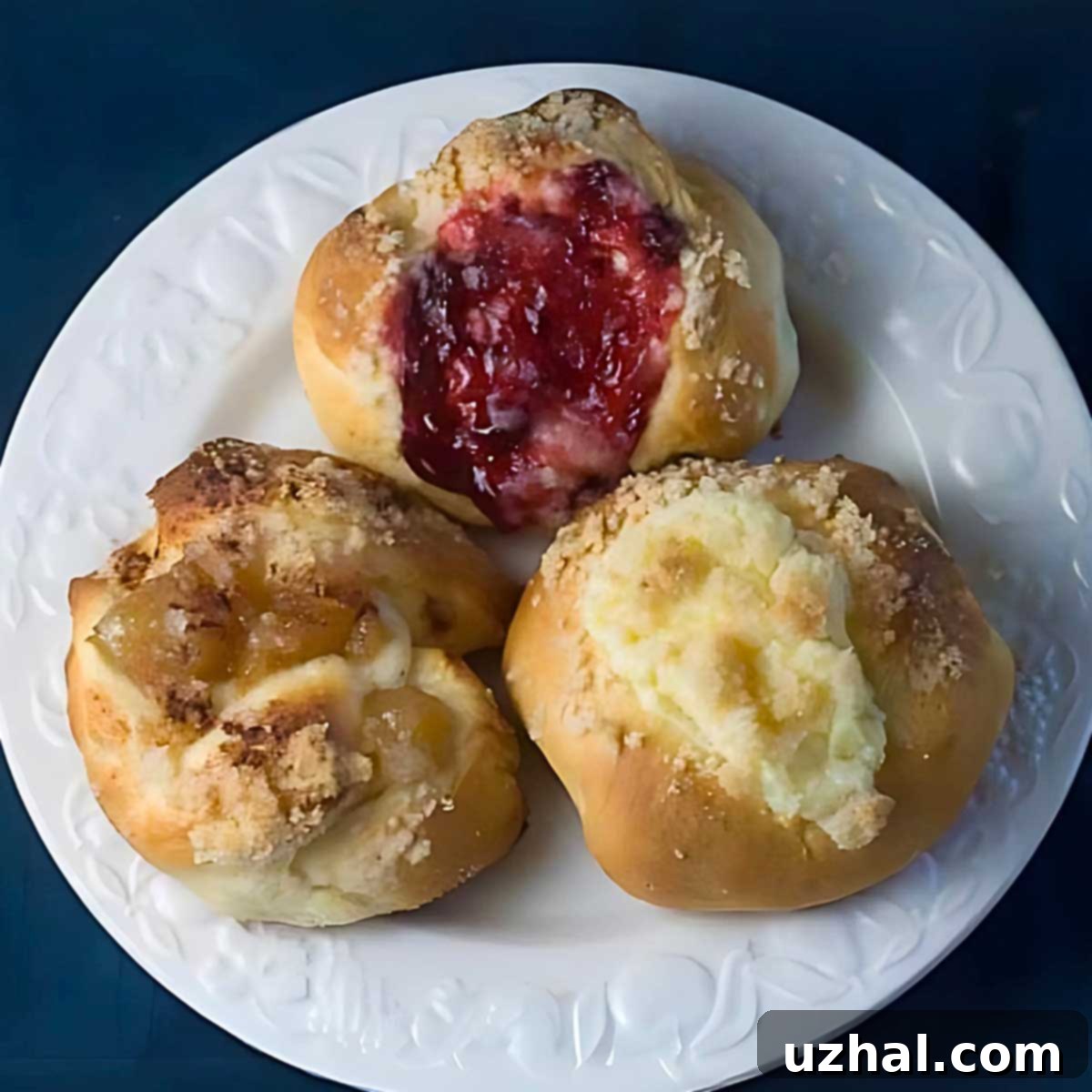The Ultimate Guide to Delicious Cream Cheese Kolaches: A Classic Czech Pastry Recipe
There’s a reason why some foods become staples, cherished for generations. Kolaches, with their soft, sweet dough and delightful fillings, are a perfect example. While I’ve often championed them as the “next big thing” in the pastry world, the truth is, they’ve *always* been a big deal, especially in my kitchen! From the moment I tasted those freshly baked apple, raspberry, and cream cheese filled kolaches, I knew they deserved a permanent spot in our home baking repertoire. They’re more than just a pastry; they’re a comforting hug in food form, a delightful treat that brings a smile to any breakfast table or afternoon tea.
Jump to Recipe

Kolaches: A Taste of Tradition
Kolaches (pronounced koh-LAH-chees) are a beloved pastry, originating from Central Europe, particularly the Czech Republic. Traditionally, they are made with a slightly sweet, yeast-leavened dough and filled with a variety of fruit preserves, poppy seeds, or a creamy cheese mixture. These delightful buns are a staple for breakfast, brunch, or as a sweet snack throughout the day. While often associated with holidays and special occasions, their simple charm makes them perfect for any day you crave a touch of homemade goodness.
My journey with kolaches began years ago, adapting a recipe that yielded a whopping 48 rolls – far more than my household could manage! Over time, I’ve perfected a scaled-down version, producing a more manageable 16 kolaches, perfect for a family treat or sharing with friends. This recipe has been refined through years of baking, focusing on achieving that ideal soft texture and rich flavor that makes homemade kolaches so irresistible.
The Secret to a Perfect Rise: Choosing Your Yeast and Flour
Baking with yeast can sometimes feel intimidating, but with the right ingredients and a little patience, you’ll be making fluffy, high-rising kolaches in no time. The quality of your yeast and flour plays a crucial role in the final texture of your pastry.
Yeast: Platinum, SAF Gold Label, and Beyond
Back in 2014, I discovered Red Star Platinum Yeast, a high-rising yeast containing dough conditioners that consistently delivered softer, higher-rising breads. It was a game-changer for cinnamon swirl bread, cream cheese braids, and dinner rolls, and it worked wonders for kolaches too.
However, the baking world evolves, and so do my preferences. While Platinum yeast is excellent if you can find it, I now almost exclusively use SAF Instant Yeast with the gold label. SAF Gold is specifically designed for sweet doughs, making it ideal for kolaches. It helps create a beautifully tender crumb and an impressive rise. If you can get your hands on fresh yeast, that’s another fantastic option, though it can be challenging to find in many areas.
Flour: Bread Flour vs. All-Purpose
For a long time, I considered bread flour a “must” for my kolaches. Its higher protein content contributes to a stronger gluten structure, resulting in a chewier, more substantial kolache. It certainly makes a beautiful pastry.
However, through continued experimentation, I’ve found that all-purpose flour also yields excellent kolaches, often a little softer in texture. The key is to be flexible with your liquid. All-purpose flour might absorb liquid differently than bread flour, so you may need to adjust the water content slightly. The most important rule, regardless of flour type, is to add your flour gradually. Flour absorption varies from kitchen to kitchen and brand to brand, so trust the feel of your dough rather than strictly adhering to exact measurements.
The Importance of Temperature for Yeast Activation
Yeast is a living organism, and like all living things, it thrives under certain conditions. For doughs where the yeast is incorporated with the flour, the liquid (milk in this case) needs to be adequately warm to kickstart the yeast without killing it. I aim for 130°F (54°C). While this might seem high to some, it’s crucial for activating the yeast when it’s mixed directly into the flour rather than proofed separately. A thermometer is your best friend here, ensuring your milk is at the perfect temperature for optimal yeast activity.
Beyond the Dough: The Magic of Fillings
While the soft, sweet dough is undeniably central to a great kolache, the fillings are where you can truly express your creativity. My personal favorite is the luscious cream cheese filling, and I’ve included its recipe for you. Its tangy sweetness perfectly complements the rich dough.
But don’t stop there! Kolaches are incredibly versatile. For fruit lovers, you can create your own fillings from fresh fruit or use good quality canned fruit pie fillings. Popular fruit choices include:
- Apple (often spiced with cinnamon)
- Raspberry or other berry jams
- Prune butter (lekvar)
- Apricot preserve
- Poppy seed paste
Some people even enjoy savory kolaches, filled with ingredients like sausage, sauerkraut, or potato. While I tend to keep my kolaches sweet, the possibilities are endless. Don’t be afraid to experiment with different flavors and textures to find your perfect kolache combination!
Baking for Perfection: Tips and Tricks
Achieving that signature soft side on your kolaches is a simple trick that makes all the difference:
- **Baking in Proximity:** Arrange your kolaches a few inches apart in a rimmed pan. As they rise and bake, they will gently touch each other, resulting in softer sides. This method creates a moist, tender crumb that is characteristic of the best kolaches.
- **Don’t Overbake:** Keep a close eye on your kolaches during baking. They should be golden brown, not dark. Overbaking can lead to dry kolaches, so pull them out as soon as they reach that beautiful golden hue.
- **Brushing with Butter:** A gentle brush of melted butter before and after baking (before the crumb topping for this recipe) adds moisture and a rich flavor, contributing to that desirable soft crust.
Updates 2024: Refining the Process
Baking is an ongoing learning process, and over the years, I’ve refined some of my techniques and recommendations:
- As mentioned, while Platinum yeast is good, I now almost exclusively use SAF gold label for its consistent performance in sweet doughs. Fresh yeast remains my ultimate dream, but it’s incredibly hard to source in Raleigh, NC in 2024.
- Bread flour is no longer an absolute “must,” though it makes a lovely kolache. All-purpose flour also creates excellent kolaches, and you might find them even softer. Remember to adjust the liquid as needed.
- Always add flour gradually, regardless of type. Different flours and kitchen environments (humidity) will affect liquid absorption. Start with the lower end of the flour range and add more until your dough reaches the desired consistency – soft, slightly sticky before kneading, then smooth and elastic after.
- Baking kolaches a few inches apart in a rimmed pan, allowing them to rise together and touch in the oven, remains my top tip for incredibly soft sides.
Making kolaches is a rewarding experience. The aroma filling your kitchen, the satisfaction of kneading the dough, and finally, the joy of biting into a warm, homemade kolache are unparalleled. Whether you’re a seasoned baker or new to yeast doughs, this recipe is designed to guide you to success.
If you try this recipe, please let me know what you think! Your feedback helps me and other bakers improve. And remember, my favorite filling is cream cheese, but feel free to explore other fruit or even savory options.
- Soft Flax Bread
- Quick Rising Yeast Chocolate Bread
- Kolaches With Sour Cream Dough
- Pudding Mix Kolaches
- Pumpkin Spice Kolaches with Cream Cheese
Recipe: Classic Cream Cheese Kolaches

Cream Cheese Filled Kolaches
Anna
Pin Recipe
Ingredients
Dough
- 1 cup milk (230-240 grams)
- 5 ½ tablespoons unsalted butter, softened, plus more for brushing (74 grams)
- ¼ cup granulated sugar (50 grams)
- 1 large egg yolk
- 2 ½ to 3 cups all-purpose or bread flour (315 to 380 grams)**
- 1 teaspoon salt, scant
- 2 ¼ teaspoons SAF instant yeast (you can use Platinum or another high-quality instant yeast)
Crumb Topping
- ⅓ cup granulated sugar 65 grams
- 2 ½ tablespoons flour 20 grams
- ⅛ teaspoon cinnamon
- 4 teaspoons melted butter 18 grams
Cream Cheese Filling
- 8 oz cream cheese, softened (230 grams)
- 1 large egg yolk
- ¼ cup sugar (50 grams)
- Pinch of lemon zest
- ½ teaspoon vanilla extract
Instructions
-
Gently heat the milk in a microwave-safe measuring cup or small saucepan until it just begins to simmer, but not boil. Let it cool to precisely 130°F (54°C). This temperature is crucial for activating the yeast without scalding it.
-
While the milk is cooling, combine the 5 ½ tablespoons of softened butter and granulated sugar in a large mixing bowl. Beat them together with a spoon until well combined. Stir in the egg yolk, 2 cups (250 grams) of the flour, salt, and instant yeast. The mixture will appear crumbly and dry at this stage. Gradually add the cooled milk and stir until all ingredients are thoroughly mixed. From this point, add the remaining flour (up to 1 cup, or 130 grams) a quarter cup at a time, stirring with a large spoon or sturdy scraper, until you achieve a soft dough. The dough should be slightly sticky to the touch – leaning more towards sticky than dry, as kneading will reduce some of the stickiness.
-
If using a stand mixer, attach the dough hook and knead on medium-low speed for about 5-7 minutes, or until the dough is smooth, elastic, and pulls away from the sides of the bowl. If kneading by hand, turn the dough out onto a lightly floured surface and knead for 8-10 minutes until it’s smooth and pliable.
-
Lightly grease a clean mixing bowl with butter or cooking spray. Place the kneaded dough into the bowl, turning it once to coat. Cover the bowl loosely with plastic wrap or a clean kitchen towel and let it rise in a warm, draft-free place until doubled in bulk, approximately 1 hour (rising time can vary depending on room temperature).
-
Once doubled, gently punch down the dough to release the air. Turn it out onto a lightly floured surface. Divide the dough into 16 equal-sized portions. Shape each portion into a smooth ball or slightly oval blob. Arrange 8 dough balls on each of two baking sheets lined with parchment paper, ensuring they are a few inches apart.
-
Loosely cover the dough balls with a greased sheet of plastic wrap (to prevent sticking) and let them rise again for another hour. They should look noticeably puffy.
-
While the kolaches are undergoing their second rise, prepare the crumb topping and the cream cheese filling. For the crumb topping, simply mix all ingredients until crumbly. For the cream cheese filling, beat softened cream cheese, egg yolk, sugar, lemon zest, and vanilla until smooth and well combined.
-
After the second rise, create a deep indentation in the center of each risen dough ball using the back of a spoon or your thumb. Fill each indentation with about a tablespoon of the prepared cream cheese filling. Gently brush the exposed dough around the filling with a little melted butter and then generously sprinkle the crumb topping over both the bun and the filling.
-
Preheat your oven to 400°F (200°C) and let the filled kolaches rest on the baking sheets while the oven comes to temperature. This brief rest helps them maintain their shape and encourages a final puff.
-
Bake for approximately 15 to 20 minutes at 400°F (200°C), or until the kolaches are beautifully golden brown and the filling is set.
-
Serve warm or at room temperature. Fruit-filled kolaches are delightful warm, but I personally find the cream cheese version even better once it has cooled slightly, allowing the filling to fully set and the flavors to meld. Enjoy your homemade kolaches!
Notes
